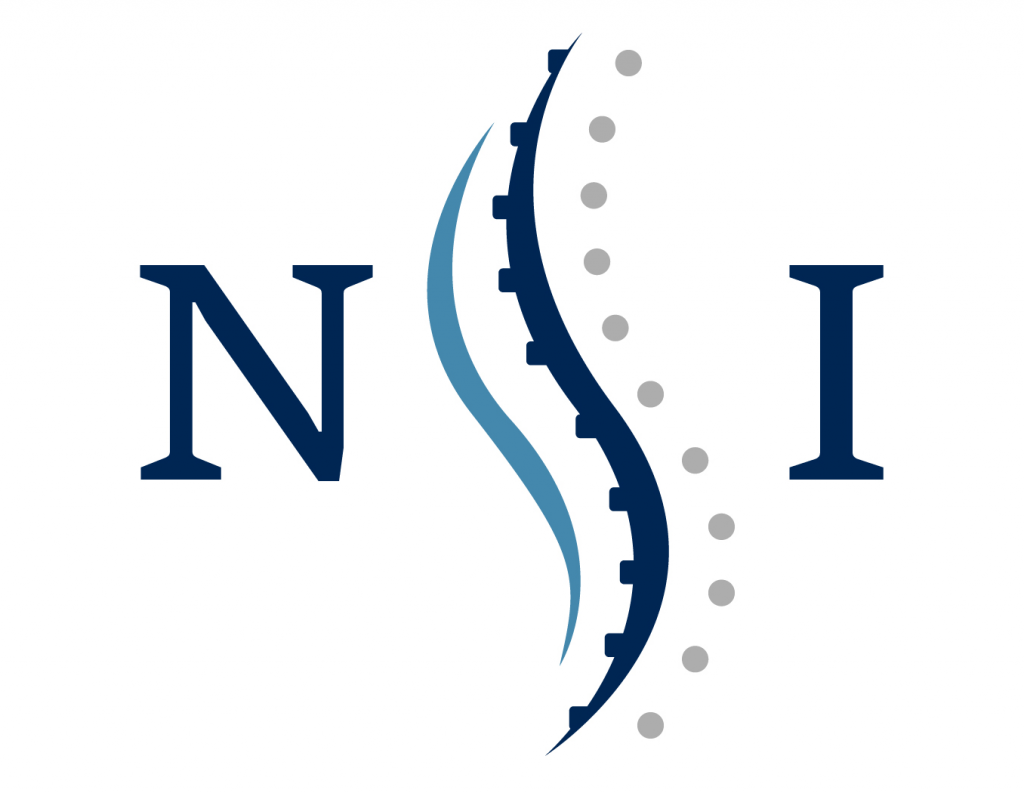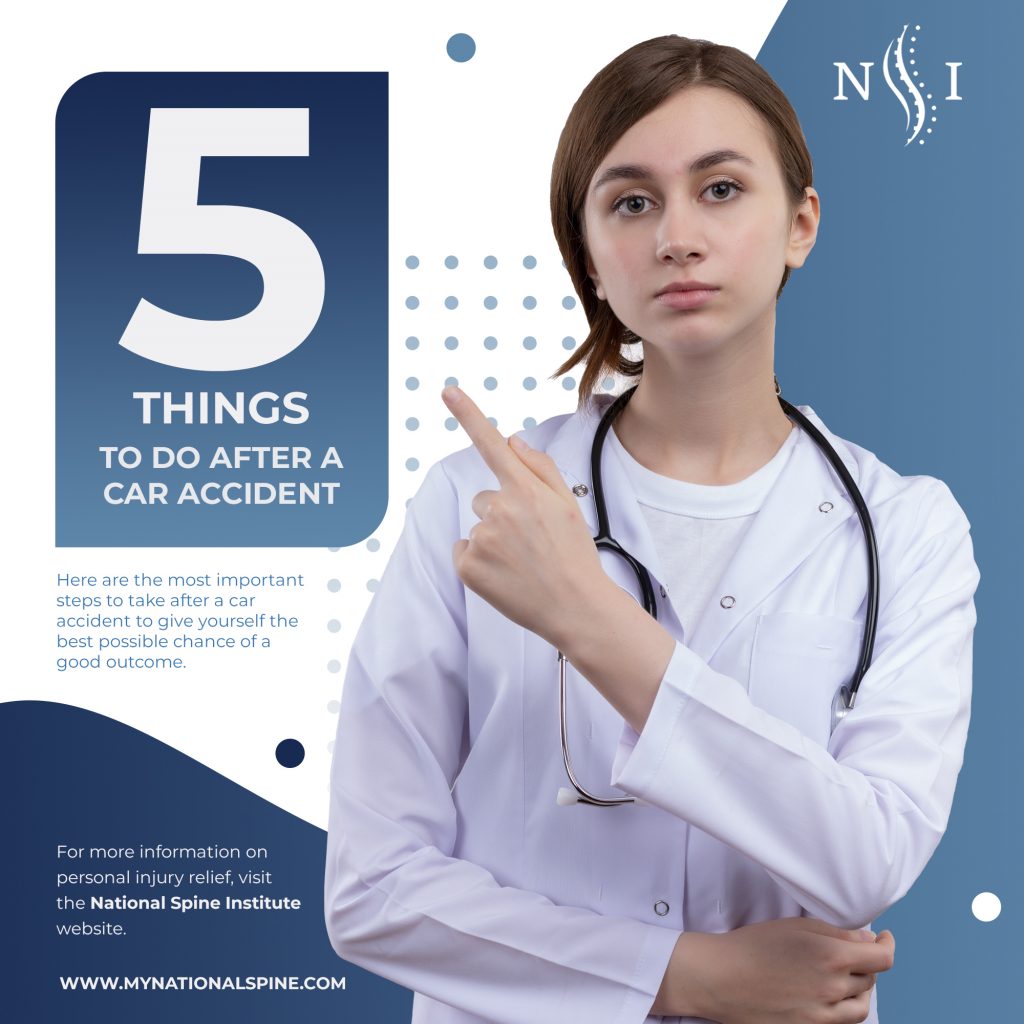5 things to do after a car accident


Five Things to Do After a Car Accident
For those affected, car accidents can have a devastating impact on your life and livelihood. In particular, automotive collisions are often associated with neck and back pain due to the extreme forces and impact on the spine. However, there can be a wide range of injuries that result from a car accident.
While the best way to prevent a vehicle-related injury is to avoid being in an accident, a car crash can happen to anyone despite our best efforts to prevent them. While we should always practice safe, defensive and focused driving, it is also critical to be prepared just in case you ever find yourself in a car accident.
At National Spine Institute, we are passionate about helping people find the relief they deserve from neck or back pain, particularly when it is caused by personal injury related to motor vehicle accidents. Please take some time to read over the following steps that anyone should take after experiencing a car accident and don’t hesitate to reach out if you have any questions or would like to learn more about your options for relief.
1. Do Everything Possible to Stay Safe at the Scene
Always put safety first if you are involved with any type of motor vehicle collision. This means first, assess the immediate injury level of yourself and anyone else in your vehicle. If you are able to, move the vehicle out of traffic and put on your hazard lights. Be very careful exiting the car to ensure you can do so safely and without worsening your injury. Determine if anyone at the scene requires immediate emergency medical attention.
If you have road flares or reflective triangles, put them around your vehicle, especially if it is dark outside or there is low visibility. Unless they appear to be seriously injured and require medical attention, minimize contact with the other party until first responders arrive. Do not discuss any details of the accident, particularly who may or may not have been at fault.
It is important to stay on the scene of the accident, even if you do not appear to be injured and it was just a minor “fender bender,” it is still important to stay at the scene.
2. Stay Calm, Notify Authorities and Record as Much Information As You Can
This step demonstrates the importance of being prepared, even for the relatively unlikely event of a car accident. First, you should always make sure your mobile phone is charged and functional so you can contact any needed authorities, including the police and emergency responders. If anyone requires medical attention, ensure that someone has called 911 before anything else. Always err on the side of caution, as spine injuries and traumatic brain injuries can very often be more serious than they initially appear. A trained paramedic should make the proper assessment.
Next, you should always have your license, registration and insurance information with you and accessible at all times.
No matter how minor the accident, it is strongly recommended to contact the police to file an accident report. Even if an officer does not arrive on the scene, you should request a copy of the accident report and be willing to provide as much information as you can about the facts of the accident.
Important steps to take if it safe to do so include:
- Record the time and date of the accident
- Taking pictures of the scene and any damage to the vehicles
- Writing a description of the events and drawing a diagram while the information is still fresh
- Taking pictures of insurance information of the other party
Do not disclose any confidential information, including your social security number. Do not disclose the coverage limits of your insurance policy.
Immediately contact your insurance provider and report the accident. The risks of not reporting almost always outweigh any potential costs of reporting the accident.
3. Always Get Yourself Examined by A Doctor
The hours and days following a car accident are critical to your health. Even if you are able to walk away from the accident with no apparent injury, you should always get checked out by a qualified medical professional, such as your doctor. Doing this as soon as possible after the accident can not only help you get a jump on the recovery process if needed, but it also establishes a medical record from the beginning, which can be very important down the road.
Certain automotive-related injuries, including whiplash, can have a delayed onset of symptoms. By receiving an early diagnosis, you can establish that the source of pain was connected to the car accident and take appropriate steps.
To diagnose and treat an injury after a car accident, doctors will generally take the following steps:
- Review your health and treatment history
- Ask questions about the accident and what parts of the body may have been affected
- Discuss any symptoms or mobility problems that have developed
- Perform a full examination that includes a hands-on evaluation as well as balance and movement tests
- Order any diagnostic testing and imagery needed to confirm a diagnosis or rule out certain injuries
Herniated discs, pinched nerves, spinal fractures, and narrowing of the spinal canal are common injuries that develop after a car crash. It’s critical that anyone involved in a car accident receive this as soon as possible to identify potential injuries early. While some symptoms do develop immediately after a crash, others take weeks or even longer to become noticeable. Not being proactive in your treatment of neck and/or back pain from a car accident, even if it’s minor, can have long-term consequences, including chronic pain and limited mobility.
4. Be Proactive About Treatment and Take a Long-Term Approach
If you’re diagnosed with a spine condition such as a herniated disc, bulging disc or pinched nerve after your car accident, there are a number of important steps you can take to ensure the best possible treatment outcome. A common misconception is that spine surgery is required for spine injuries, when the reality is that conservative treatments are very often effective.
Work with your doctor or other treatment professional to create an effective treatment plan that fits your needs and lifestyle goals. Pain relieving options include:
- Rest
- Over-the-counter anti-inflammatory medication
- Physical therapy
- Pain-relieving steroid injections
- Alternating hot and/or cold therapy
- Healthy lifestyle options, including regular exercise, good nutrition and weight management
If conservative therapy is fully exhausted without finding the relief necessary for a good quality of life, surgery can offer an effective means of relief. Fortunately, due to advances in technology and surgical training, minimally invasive, outpatient spine surgery helps patients overcome pain with less risk of complication and a shorter recovery compared to traditional open back surgery.
5. Explore Your Legal Options
If you’ve been in an auto accident and suffered an injury, it might be a good idea to seek legal representation. From protecting yourself, to ensuring that your insurance provider covers any and all necessary medical expenses, experienced attorneys can help you navigate the often complex world of personal injury protection. Ask among your personal or professional network and do any due diligence in your research to find legal representation with the right mix of experience and expertise for your needs.
Reach Out to National Spine Institute for Accident-Related Neck or Back Pain
Being involved in any kind of automobile accident can seriously increase your risk of spinal injury even in seemingly minor collisions. At the National Spine Institute, our providers have years of experience assessing and diagnosing common neck and back problems that develop from motor vehicle collisions. We know how to work closely with injury lawyers and insurance providers to make sure that people injured in a car accident receive the best care and treatment.
Contact our caring team today to learn more.
